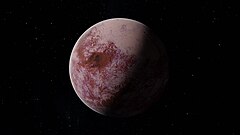| Revision as of 16:00, 31 May 2021 editCitation bot (talk | contribs)Bots5,414,844 edits Alter: title. | Use this bot. Report bugs. | Suggested by Neko-chan | Category:Terrestrial planets | #UCB_Category 19/54← Previous edit | Revision as of 11:17, 27 July 2021 edit undoDouble sharp (talk | contribs)Autopatrolled, Extended confirmed users, Page movers, File movers, Pending changes reviewers102,021 edits →Pluto and candidates: uncited; it's equally possible that P9, should it exist, turns out to be a mini-NeptuneNext edit → | ||
| Line 11: | Line 11: | ||
| == Pluto and candidates == | == Pluto and candidates == | ||
| Although there are many icy objects in the ], there are no known ice planets (though ] was considered an ice planet until its ]).<ref name="Wiley-2005">{{cite web |last1=Stern |first1=Alan |last2=Mitton |first2=Jacqueline |author-link2=Jacqueline Mitton |title=Pluto and Charon : ice worlds on the ragged edge of the solar system |url=http://www.worldcat.org/search?q=isbn%3A3527405569 |date=2005 |publisher=Weinheim: ] |access-date=July 13, 2013 }}</ref> |
Although there are many icy objects in the ], there are no known ice planets (though ] was considered an ice planet until its ]).<ref name="Wiley-2005">{{cite web |last1=Stern |first1=Alan |last2=Mitton |first2=Jacqueline |author-link2=Jacqueline Mitton |title=Pluto and Charon : ice worlds on the ragged edge of the solar system |url=http://www.worldcat.org/search?q=isbn%3A3527405569 |date=2005 |publisher=Weinheim: ] |access-date=July 13, 2013 }}</ref> | ||
| If a ] suggested in 2016 is found, it will be an ice planet of many times the Earth's mass with a surface temperature potentially under 70K. | |||
| There are several extrasolar ice planet candidates, including ], OGLE-2013-BLG-0341LB b and ]. | There are several extrasolar ice planet candidates, including ], OGLE-2013-BLG-0341LB b and ]. | ||
Revision as of 11:17, 27 July 2021
This article is about the type of planet smaller than giant planets. For the film, see Ice Planet (film). For the type of giant planet, see ice giant.| This article needs additional citations for verification. Please help improve this article by adding citations to reliable sources. Unsourced material may be challenged and removed. Find sources: "Ice planet" – news · newspapers · books · scholar · JSTOR (May 2014) (Learn how and when to remove this message) |

An ice planet is a theoretical type of exoplanet with an icy surface of volatiles such as water, ammonia, and methane. Ice planets consist of a global cryosphere. They are bigger versions of the small icy worlds of the Solar System, which includes the moons Europa, Enceladus, and Triton, the dwarf planets Pluto and Eris, and many other small Solar System bodies such as comets. In June 2020, NASA scientists reported that it is likely that exoplanets with oceans, including some oceans that may be frozen, may be common in the Milky Way galaxy, based on mathematical modeling studies.
Characteristics and habitability


Ice planets usually appear nearly white with geometric albedos of more than 0.9. An ice planet's surface can be composed of water, methane, ammonia, carbon dioxide (known as "dry ice"), carbon monoxide, and other volatiles, depending on its surface temperature. Ice planets would have surface temperatures below 260 K (−13 °C) if composed primarily of water, below 180 K (−93 °C) if primarily composed of CO2 and ammonia, and below 80 K (−193 °C) if composed primarily of methane.
On the surface, ice planets are hostile to life forms like those living on Earth because they are extremely cold. Many ice worlds likely have subsurface oceans, warmed by internal heat or tidal forces from another nearby body. Liquid subsurface water would provide habitable conditions for life, including fish, plankton, and microorganisms. Subsurface plants as we know them could not exist because there is no sunlight to use for photosynthesis. Microorganisms can produce nutrients using specific chemicals (chemosynthesis) that may provide food and energy for other organisms. Some planets, if conditions are right, may have significant atmospheres and surface liquids like Saturn's moon Titan, which could be habitable for exotic forms of life.
Pluto and candidates
Although there are many icy objects in the Solar System, there are no known ice planets (though Pluto was considered an ice planet until its reclassification in 2006).
There are several extrasolar ice planet candidates, including OGLE-2005-BLG-390Lb, OGLE-2013-BLG-0341LB b and MOA-2007-BLG-192Lb.
See also
References
- NASA (18 June 2020). "Are planets with oceans common in the galaxy? It's likely, NASA scientists find". EurekAlert!. Retrieved 20 June 2020.
- Shekhtman, Lonnie; et al. (18 June 2020). "Are Planets with Oceans Common in the Galaxy? It's Likely, NASA Scientists Find". NASA. Retrieved 20 June 2020.
- Stern, Alan; Mitton, Jacqueline (2005). "Pluto and Charon : ice worlds on the ragged edge of the solar system". Weinheim: Wiley-VCH. Retrieved July 13, 2013.
| Exoplanet search projects | |||||||||||
|---|---|---|---|---|---|---|---|---|---|---|---|
| Ground-based |
|   | |||||||||
| Space missions |
| ||||||||||
| Related | |||||||||||
